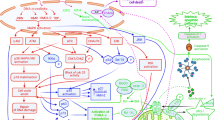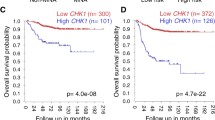Abstract
Cancer treatment is in the need of selective drugs that can interfere specifically with signalling pathways affected during the carcinogenic process. Identification of new potential molecular targets is the key event in the design of new anticancer strategies. Once identified, attempts for the generation of specific molecules to regulate their function can be achieved. The relevance of deregulation of choline kinase (ChoK, E.C. 2.7.1.32) in oncogene-driven cell transformation has been previously demonstrated. Here we provide strong evidence that MN58b, a selective inhibitor of ChoK, is rather specific to this enzyme, with no effect on a variety of oncogene-activated signalling pathways involved in the regulation of cell proliferation. MN58b does not affect MAPKs, PI3K, and other enzymes involved in the regulation of phospholipid metabolism such as phospholipases C, D, and A2, CTP:phosphocholine cytidylyltransferase, or diacylglycerol choline-phosphotransferase. Consistent with this specificity, ectopic expression of ChoK resulted in resistance to its inhibitor. Finally, nontransformed cells were able to resume cell proliferation after removal of the drug, while transformed cells were irreversibly affected. These results indicate that inhibition of ChoK is a rather specific strategy for the cytotoxic treatment of transformed cells.
This is a preview of subscription content, access via your institution
Access options
Subscribe to this journal
Receive 50 print issues and online access
$259.00 per year
only $5.18 per issue
Buy this article
- Purchase on Springer Link
- Instant access to full article PDF
Prices may be subject to local taxes which are calculated during checkout






Similar content being viewed by others
References
Aboagye EO and Bhujwalla ZM . (1999). Cancer Res., 59, 80–84.
Ansell GB and Spanner SG . (1974). J. Neurochem., 22, 1153–1155.
Baburina I and Jackowski S . (1999). J. Biol. Chem., 274, 9400–9408.
Bhakoo KK, Williams SR, Florian CL, Land H and Noble MD . (1996). Cancer Res., 56, 4630–4635.
Cannon JG . (1994). Med. Res. Rev., 14, 505–531.
Cantley LC, Auger KR, Carpenter C, Duckworth B, Graziani A, Kapeller R and Soltoff S . (1991). Cell, 64, 281–302.
Carnero A, Cuadrado A, del Peso L and Lacal JC . (1994). Oncogene, 9, 1387–1395.
Chung T, Crilly KS, Anderson WH, Mukherjee JJ and Kiss Z . (1997). J. Biol. Chem., 272, 3064–3072.
Chung T, Huang JS, Mukherjee JJ, Crilly KS and Kiss Z . (2000). Cell Signal, 12, 279–288.
Cuadrado A, Carnero A, Dolfi F, Jimenez B and Lacal JC . (1993). Oncogene, 8, 2959–2968.
de Certaines JD, Larsen VA, Podo F, Carpinelli G, Briot O and Henriksen O . (1993). NMR Biomed., 6, 345–365.
Finney RE, Nudelman E, White T, Bursten S, Klein P, Leer LL, Wang N, Waggoner D, Singer JW and Lewis RA . (2000). Cancer Res., 60, 5204–5213.
Franke TF, Yang SI, Chan TO, Datta K, Kazlauskas A, Morrison DK, Kaplan DR and Tsichlis PN . (1995). Cell, 81, 727–736.
Friend SH and Oliff A . (1998). N. Engl. J. Med., 338, 125–126.
Gibbs JB and Oliff A . (1994). Cell, 79, 193–198.
Gillies RJ, Didier N and Denton M . (1986). Anal. Biochem., 159, 109–113.
Hernández-Alcoceba R, Fernandez F and Lacal JC . (1999). Cancer Res., 59, 3112–3118.
Hernández-Alcoceba R, Saniger L, Campos J, Nunez MC, Khaless F, Gallo MA, Espinosa A and Lacal JC . (1997). Oncogene, 15, 2289–2301.
Jackowski S . (1994). J. Biol. Chem., 269, 3858–3867.
Jiménez B, del Peso L, Montaner S, Esteve P and Lacal JC . (1995). J. Cell. Biochem., 57, 141–149.
Kim KH and Carman GM . (1999). J. Biol. Chem., 274, 9531–9538.
Kiss Z and Chung T . (1996). Biochem. Biophys. Res. Commun., 218, 505–509.
Ko KW, Cook HW and Vance DE . (1986). J. Biol. Chem., 261, 7846–7852.
Lacal JC . (1990). Mol. Cell. Biol., 10, 333–340.
Lacal JC . (2001). I Drugs, 4, 419–426.
Lacal JC, Moscat J and Aaronson SA . (1987). Nature, 330, 269–272.
Lewin B . (1991). Cell, 64, 303–312.
Lykidis A and Jackowski S . (2001). Prog. Nucleic Acid Res. Mol. Biol., 65, 361–393.
Macara IG . (1989). Mol. Cell. Biol., 9, 325–328.
Momchilova A, Markovska T and Pankov R . (1999). Cell Biol. Int., 23, 603–610.
Oikawa T, Esaki N, Tanaka H and Soda K . (1991). Proc. Natl. Acad. Sci. USA, 88, 3057–3059.
Ramirez de Molina A, Gutierrez R, Ramos MA, Silva JM, Silva J, Bonilla F, Sanchez JJ and Lacal JC . (2002a). Oncogene, 21, 4317–4322.
Ramirez de Molina A, Penalva V, Lucas L and Lacal JC . (2002b). Oncogene, 21, 937–946.
Ramírez de Molina A, Rodríguez-González A, Gutiérrez R, Martínez-Piñeiro L, Sánchez JJ, Bonilla F, Rosell R and Lacal JC . (2002c). Over-expression of choline kinase is a frequent feature in human tumor-derived cell lines and in lung, prostate and colorectal human cancers. Biochem. Biophys. Res. Commun., 296, 580–583.
Ramirez De Molina A, Rodriguez-Gonzalez A and Lacal JC . (2001). Int. J. Oncol., 19, 5–17.
Ramirez de Molina A, Rodriguez-Gonzalez A, Penalva V, Lucas L and Lacal JC . (2001). Biochem. Biophys. Res. Commun., 285, 873–879.
Ratmant JC and Kent C . (1995). Arch. Biochem. Biophys., 323, 313–322.
Rodriguez-Viciana P, Warne PH, Dhand R, Vanhaesebroeck B, Gout I, Fry MJ, Waterfield MD and Downward J . (1994). Nature, 370, 527–532.
Smith TA, Bush C, Jameson C, Titley JC, Leach MO, Wilman DE and McCready VR . (1993). NMR Biomed., 6, 318–323.
Teegarden D, Taparowsky EJ and Kent C . (1990). J. Biol. Chem., 265, 6042–6047.
Ting YL, Sherr D and Degani H . (1996). Anticancer Res., 16, 1381–1388.
Uchida T . (1996). Biochim. Biophys. Acta, 1304, 89–104.
Vanhaesebroeck B and Alessi DR . (2000). Biochem. J., 346, (Part 3) 561–576.
Warden CH and Friedkin M . (1985). J. Biol. Chem., 260, 6006–6011.
Warne PH, Viciana PR and Downward J . (1993). Nature, 364, 352–355.
Wieprecht M, Wieder T and Geilen CC . (1994). Biochem. J., 297, 241–247.
Yang W, Hendrickson WA, Crouch RJ and Satow Y . (1990a). Science, 249, 1398–1405.
Yang W, Hendrickson WA, Kalman ET and Crouch RJ . (1990b). J. Biol. Chem., 265, 13553–13559.
Acknowledgements
We thank Drs MA Gallo and A Espinosa for helpful discussions. This work was supported by Grants 2FD1997-1569 and SAF2001-2042 from MCYT and Grants FIS03-C03/10 and FIS03-C03/08, from MSyC. AR-G is a fellow from Gobierno Vasco, Grant (ref: BFI98.124). ARM is a fellow from Fondo de Investigación Sanitaria (Instituto de Salud Carlos III), Grant BEFI 99/9125 (ref: CPC/CLC).
Author information
Authors and Affiliations
Corresponding author
Rights and permissions
About this article
Cite this article
Rodríguez-González, A., de Molina, A., Fernández, F. et al. Inhibition of choline kinase as a specific cytotoxic strategy in oncogene-transformed cells. Oncogene 22, 8803–8812 (2003). https://doi.org/10.1038/sj.onc.1207062
Received:
Revised:
Accepted:
Published:
Issue Date:
DOI: https://doi.org/10.1038/sj.onc.1207062
Keywords
This article is cited by
-
Design, synthesis, crystallization and biological evaluation of new symmetrical biscationic compounds as selective inhibitors of human Choline Kinase α1 (ChoKα1)
Scientific Reports (2016)
-
A new family of choline kinase inhibitors with antiproliferative and antitumor activity derived from natural products
Clinical and Translational Oncology (2015)
-
Choline kinase-alpha by regulating cell aggressiveness and drug sensitivity is a potential druggable target for ovarian cancer
British Journal of Cancer (2014)
-
Metabolic biomarkers for response to PI3K inhibition in basal-like breast cancer
Breast Cancer Research (2013)
-
Choline kinase inhibition induces exacerbated endoplasmic reticulum stress and triggers apoptosis via CHOP in cancer cells
Cell Death & Disease (2013)



